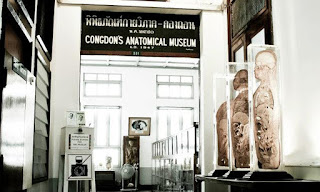https://www.atlasobscura.com/places/siriraj-medical-museumHoused in the oldest hospital - it’s where the King of Thailand goes when he is ill - and medical school in Thailand, est. 1886, the Siriraj Medical Museum abounds with medical curiosities. The Siriraj is actually comprised of six different museums: a museum of pathology, a forensics museum, a museum of the history of Thai medicine, a parasitology museum, an anatomical museum, and a prehistoric museum.
The Siriraj’s incredible holdings include: bones, preserved organs, pathological fetuses, the mummified corpse of a notorious serial killer, a traditional Thai medicine shop, parasitic worms, a two-and-a-half-foot-wide scrotum removed from a man afflicted with elephantiasis, preserved sections of human skin bearing tattoos, poisonous snakes and tarantulas, rows of skulls, the standing wax-filled remains of a cannibal, a delicately dissected nervous system, and the skeleton of the museum’s founder.
A strong stomach is recommended.
The hospital complex is home to a collection of five small museums, which are:
(1) Congdon Anatomical Museum (3rd fl., Anatomy Bldg.)
lt contains more than 2,000 specimens about human anatomy, including skeletons, figures of humans and animals, the bodies and organs of Siamese twins preserved in ethyl-alcohol, and, most importantly, perhaps one of the world’s very few complete peripheral nervous and blood systems dissected from human bodies by Associate Professor Patai Sirikaroon.
(2) Sood Sangvichien Prehistoric Museum & Laboratory (1st fl., Anatomy Bldg.)
exhibits the evolution of life forms, from 500 million years ago to the beginning of primate era around 70 million years ago. The museum is named after one of Siriraj’s greatest professors.
(3) Songkran Niyomsane Forensic Medicine Museum (2nd fl., Adulayadejvikrom Bldg.)
involves several elements in forensic science, from process of investigating the crimes by physical evidences, methods of murder, samples of skeletons and past murder cases.
(4) Parasitology Museum (7th fl., Adulayadejvikrom Bldg.)
exhibits various kinds of parasites such as whipworms and roundworms are exhibited, with models of their life-cycle.
(5) EIlis Pathological Museum (8th fl. Adulayadejvikrom Bldg.)
shows the evolution of medicine, and organs infected with different diseases.
Murder - crashes - disasters - rape
Anatomical Museum




















No comments
Post a Comment